Baking the perfect potato is an easier food and cooking technique than you might think.

Of course, since people’s preferences can vary quite a bit, what constitutes a truly perfect baked potato can differ depending on the person. Luckily, this guide to making the perfect potato allows for several variations so that you can choose the perfect potato to suit your preferences. No matter what variation you pick, they all have one thing in common: they’re all simple, and they all yield potatoes that are the absolute pinnacle of comfort food bliss.
For a classic baked potato, you’ll want to use the oven — however, it’s possible to cook a baked potato in the microwave, too. Instructions for both are listed below.
Recipe notes:

What kind of potatoes should I use?
For a classic baked potato, use a starchy potato such as a Russet (you know, the kind that looks like Mr. Potato Head). If you are in doubt about which types of potatoes are starchy, ask someone in the produce department in your local market. However, these basic methods of baking potatoes will also work with many other varieties, including yams and sweet potatoes.
Prepping your potatoes
Before baking potatoes, thoroughly clean and dry your potatoes. Avoid potatoes with bruises, and either avoid or cut off any “eyes” before baking.
Cooking time variances
The cooking times listed in the below recipes are based on a medium (approximately 5-ounce) potato. For larger potatoes, or if you are cooking more than one potato at a time, you will need to increase the baking times; simply begin to monitor the potato after the times specified in the recipes, and check on the potatoes every 5 or so minutes until they have cooked to the right consistency.
Do you like a very soft potato?
Once the potato is done, turn off the oven but leave the potato in the residual heat. It will continue to slightly soften, and the oven’s heat will keep it warm if you still have other dishes to prepare for a meal.
Seasoning the potato
In the oven recipes below, it is suggested that you brush the potatoes with olive oil or melted butter and sprinkle with salt before baking. Not only does this do something magical for the flavor of the potato skin, but the moisture and fat also keeps the skin from becoming leathery in texture.
How do you reheat a potato?
Unfortunately, a baked potato will shrivel slightly when it cools or if it is chilled. You can reheat it and minimize further shrinkage by covering the potato and heating in a 250 degree F oven until it has reached your desired temperature.
Help! I made too many baked potatoes.
No problem. You can “upcycle” your potatoes by dicing them and adding them to a stir fry, dicing them and frying as hash browns as a brunch dish (don’t forget the overnight French toast casserole for brunch, too!), or mashing them and pan frying them into potato cakes.
“Po-tay-to” or “po-tah-to”?
Let’s call the whole thing off. After all, this is a cooking lesson, not a pronunciation lesson.
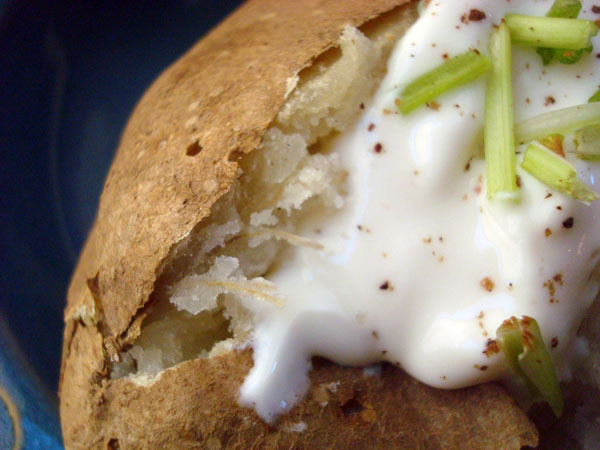
How should I serve them?
Classic serving suggestions include serving the potatoes split down the middle and filled with butter, cheese, or sour cream and chives. Elevate your perfectly baked potatoes with homemade butter and homemade cheese.
Baking a perfect potato in the oven
For an assertively crispy potato skin:
If you like a nice, crispy potato skin, this is the recipe for you.
Step 1:
Preheat oven to 425 degrees F.
Step 2:
Prick the potato about 12 times all over with the tines of a fork. Not too deep so that the tines stick and need to be jiggled to come out, but firm enough to puncture the flesh of the potato.

Step 3:
Brush the potato with olive oil or melted butter. Sprinkle with coarse sea salt.
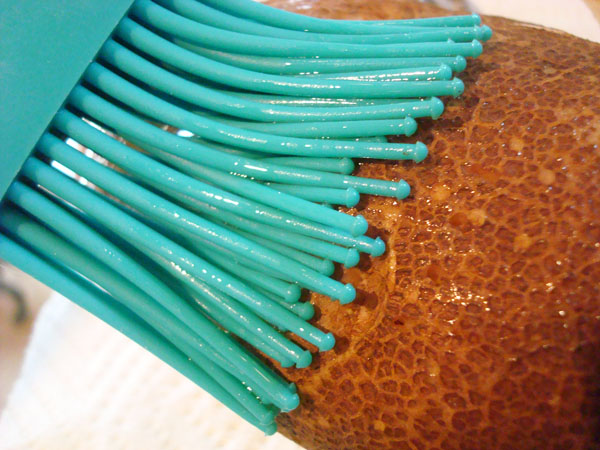
Step 4:
Place directly on top of the oven rack. Place a pan beneath to catch any drippings.

Step 5:
Bake for 45-60 minutes, or until the potato is yielding to the touch (go ahead and give it a squeeze, wearing an oven mitt). The larger the potato, the longer it will take. Remove from the oven, and lightly cut with a knife or pierce with a fork. It should go straight through to the center with no resistance. If there is resistance, it needs to cook more.
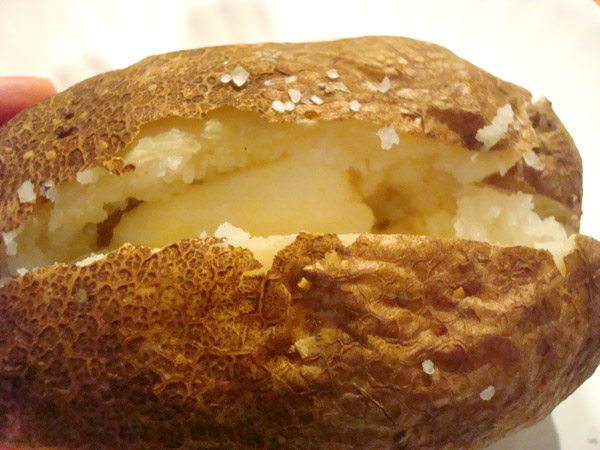
For a somewhat crispy potato skin
Follow the same basic steps as above, but bake at 350 degrees F for 60-75 minutes. Follow the same procedure to test for doneness, keeping in mind that if you are baking a large potato or more than one potato, the baking time will increase.
For a soft potato skin
Follow the same basic steps as above, but with the following changes:
Wrap the potato in foil before putting it in the oven. Aluminum is a fantastic conductor of heat, so even though you will be baking at a lower temperature, it will help keep the heat concentrated on the potato. Additionally, the foil will retain the steam released from the potato, and tends to keep things softer.

Bake the potato at 325 degrees F for 90-105 minutes, or until the potato is yielding to the touch. Follow the same procedure to test for doneness, keeping in mind that if you are baking a large potato or more than one potato, the baking time will increase.
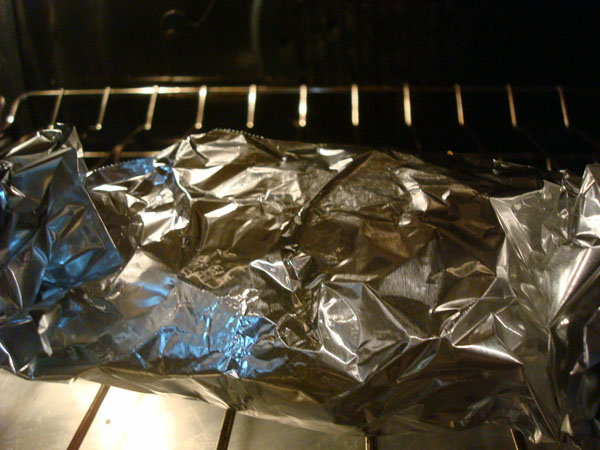
Baking the perfect potato in the microwave
If you’re in a time pinch, it’s easy to cook a baked potato in the microwave (and then you can use the microwave to make cake for dessert, of course). This type of steaming will yield a very soft potato. If you prefer a little bit crispier of a skin, cook in the microwave for a minute less than suggested, then transfer to a 450 degree oven for about 10 minutes. That should do the trick.
Step 1:
Wet a paper towel so that it is moist, not dripping. Place it on a microwave-safe plate.
Step 2:
Prick the potato about 12 times all over with the tines of a fork. Not too deep so that the tines stick and need to be jiggled to come out, but firm enough to puncture the flesh of the potato.
Step 3:
Cook on high for 7 minutes. Check the texture of the potato. If you’d like it softer, bake in minute intervals, checking after each blast of heat to see if your ideal texture has been attained.
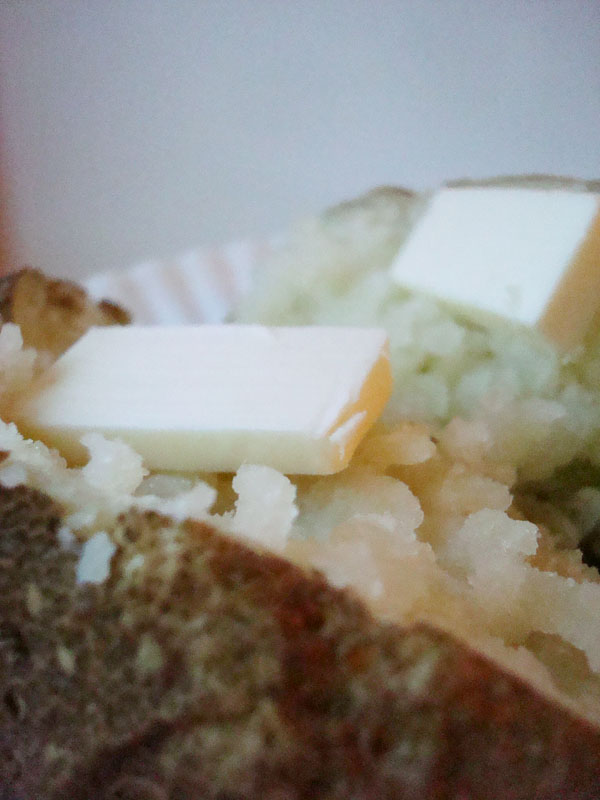
Baked potatoes pair perfectly with roast recipes like the ones Molly Stevens teaches in the online class Roasting Techniques Every Cook Should Know.

Share tips, start a discussion or ask one of our experts or other students a question.
No Responses to “Food Lover Friday: Baking the Perfect Potato”